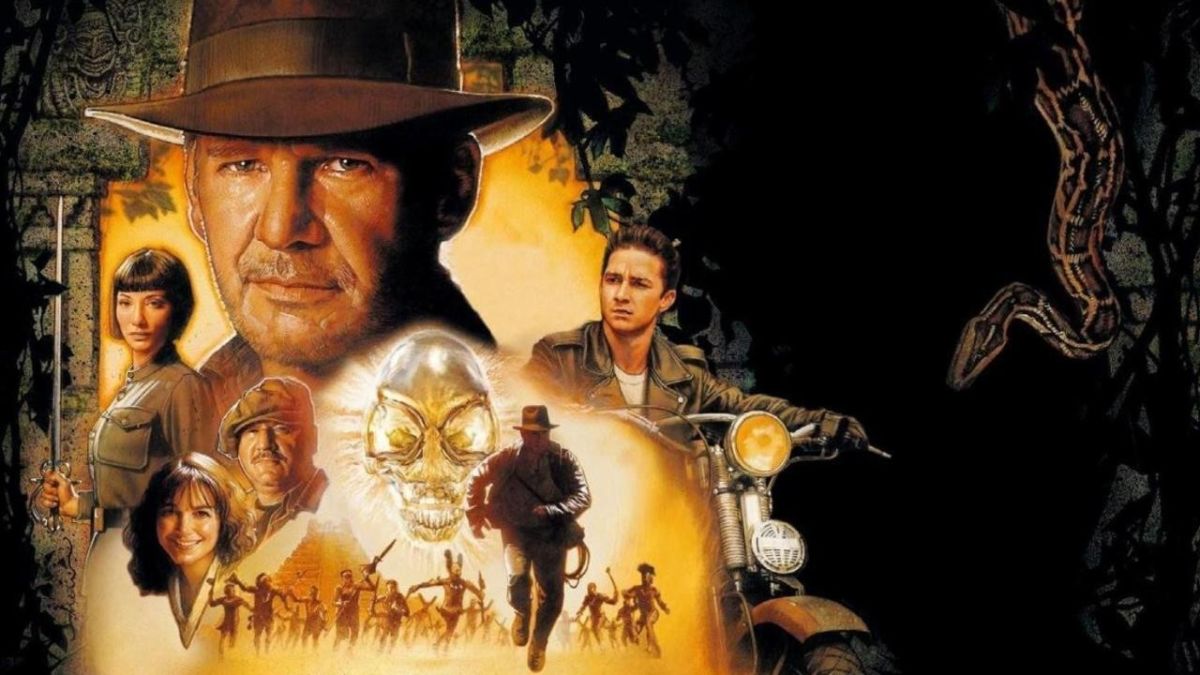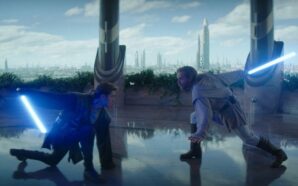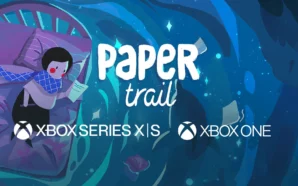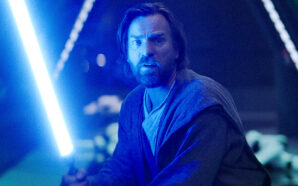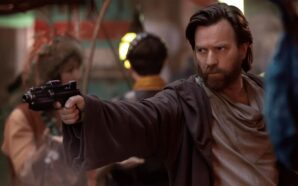Kingdom of the Crystal Skull may be the fourth Indiana Jones movie, but I also see it as the fourth Star Wars prequel too. George Lucas’s other beloved franchise also returned with a CGI-heavy follow-up, creating just as much ire in its respective fandom. Like the prequels, Crystal Skull was a big moment in my movie-going youth. I wasn’t around for the original films, watching them on TV for the first time, but here was an Indy movie I truly experiencing every aspect of. I remember the trailers, the hype, the Lego sets, and the theatrical experience. As a kid, I remember liking it, defending it even. But, despite this somewhat positive attitude, I never watch it. I stick to the original trilogy and the fourth disc of the boxset goes unplayed. But now, with Indiana Jones and the Dial of Destiny almost here, I thought I should finally revisit Kingdom of the Crystal Skull fifteen years later.
Indiana Jones fits best in the 1930s. That’s the era the character was created for, the era that makes the most sense for him. Punching Nazis and chasing artifacts at a time where the last vestiges of mysticism and the foreign unknown had yet to die out. The franchise was inspired by pulp adventure stories of that era. But a fourth film with Harrison Ford, now in his 60s, demands something else. If an Indiana Jones film is going to be set in the 1950s, as this one had to, then it might as well fully commit to this new era and shake things up. Kingdom of the Crystal Skull does just that, and while controversial, I appreciate it. From Elvis blasting on the radio from the first frame to a narrative not only inspired by the history of the time, with Soviets, McCarthyism, and greasers, but the pulp stories of the time too, now more interested with psychics, sci-fi, and flying saucers.
After decades away, in a time where the character seemingly doesn’t fit, the audience is sure to be asking “who is Indiana Jones now?” The film itself is asking this too, pre-empting viewers questions by making the film all about identity. Who even is this guy now? Kingdom of the Crystal Skull is about identity at a time when everyone’s identity was being questioned. Indy is blacklisted by his government, claimed to be something he is not, and on his way to disproving this he becomes something different: a husband and father. The ‘red scare’ paranoia challenges him and the film both questions and embraces the all-American hero as he forms a classic nuclear family at the end. The film begins with the literal destruction of a literal nuclear family in the New Mexico desert and ends with the creation of one, once Indy has successfully pushed past the fear and paranoia rampant at the time in society and within him personally.
This is a film where our hero triumphs by pitting true knowledge, gained from going out into the world and gaining lived experience, against the group think ideologies of communism and McCarthyism, represented not only by individuals but atomic bombs and spacemen, truly tying it to the era. My favourite aspect to Indy in this film is that he’s a teacher throughout, merging his two worlds. In the originals it almost seemed like a dual personality, the uptight glasses-wearing lecturer and the costumer-wearing action hero, Bruce Wayne and Batman, but here he is a meld of the two. There’s a great gag where a student asks Indy a history question in the middle of an action sequence and he takes the time to answer. Crystal Skull’s older Indiana Jones is purposefully more calm and reserved to counteract Mutt’s hotheadedness; I enjoy the character having grown and evolved since the previous films. Yet Ford still brings energy when it is needed; I disagree that this is one of his more tired, disinterested performances. His contagious delight when decoding the letter is wonderful.
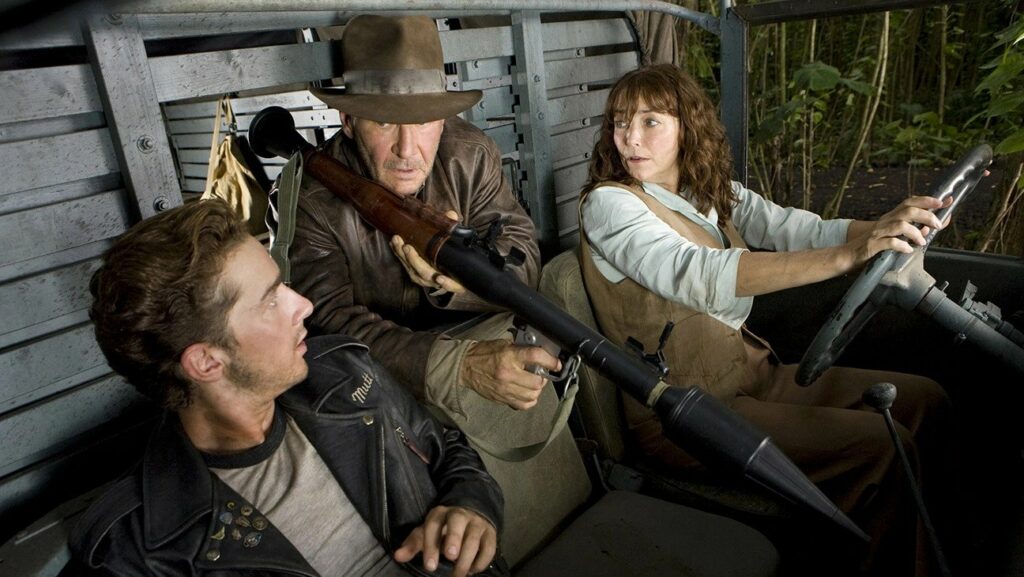
Indy finding out he’s got a son, connecting with him, growing, is a great concept for a fourth movie in this series, reflecting the relationship between Indy and his father in The Last Crusade. A beat from that film is even recreated, now flipped, with Mutt smiling at his dad after doing something cool and only being met with an unenthused expression. But what isn’t recreated is the chemistry or the genuine conflict. The two characters get on just fine for most of the film. They are largely impressed with each other. And then the ‘twist’ that they are father and son happens far too late into the film when they’ve already had the majority of their scenes together. Suddenly they are at odds… until they aren’t and the film ends. I like the idea and I like where the characters end up, especially Indy, but the drama getting them there is weak. There’s very little actual meat on the bone of the relationship.
The same is true for Indy and Marion. I’m glad to see her back and I do think she works as Indy’s ultimate love interest but on this rewatch I was shocked at how little she’s in the film and how she has almost no baring on the plot. They argue in two scenes and then the narrative drive kicks in until the ending where they are suddenly in love again and smash cut to the wedding. There’s no build to a relationship but rather just a falling back to one we largely didn’t see; it didn’t become serious until after the events of Raiders of the Lost Ark. I do enjoy the thematic aspects of Indy becoming a husband and father, of embracing aspects of his identity he was once afraid of and deciding not to run from them, but this is where the very practical scripting of events feels weaker than the ideas at play.
Judging it by the themes and big narrative beats, I think Kingdom of the Crystal Skull is a good movie. I like much of the story, most of the scenes. The issue is in the execution, the smaller details and missteps layered over everything. Much is made of the CGI and, watching it now, I agree with the complaints. It has aged very poorly. So much of it just looks silly, from fake ants and scorpions to swinging in the trees with monkeys. The vehicle chase in the jungle looks atrocious, which is a real shame considering the practical locations during the similar sequences in the originals are still exceptional and give the films a sense of reality this floaty, waxy blockbuster lacks.
The film seems so small and cheap because much of it was clearly filmed on a small set surrounded by green screen. It looks flat and over-lit; a far cry from the cinematography of the older films. The filmmakers didn’t know when to stop, when to say no, with the creativity the visual effects gave them. When Marion drives off a cliff onto a tree which lowers them into the river it looks ridiculous because the fall is so massive, whereas if she drove into the tree and then it moved her to the river it would be much better. The core ideas are fine, the execution of the moments are the issue.
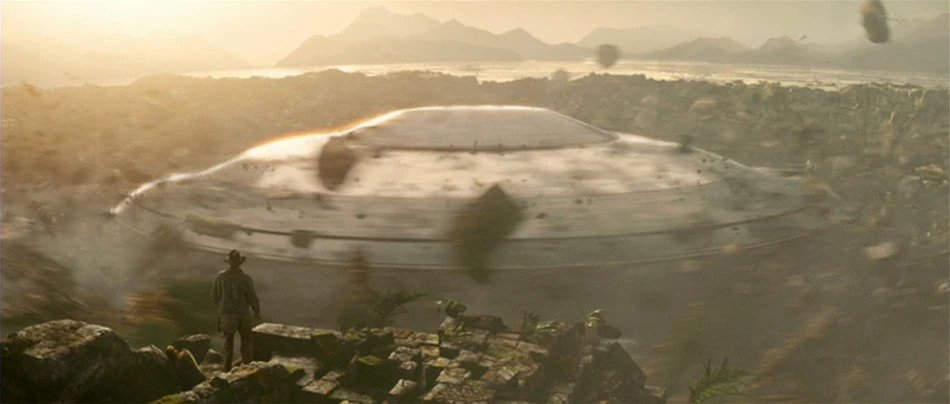
Perhaps the film’s most controversial aspect is the inclusion of aliens but there’s only one thing I dislike about this choice: that the film refuses to call them aliens. I hate the inter-dimensional being explanation. They’re aliens, just commit to it! If Spielberg is embarrassed about it then it’s no wonder much of the audience rejected the idea. I like the 50s pulp sensibility. Hell, make ‘em Martians. Aliens are just as realistic, if not more so, than the wrath of God, black magic, or 800-year-old knights in my mind. I like this new vibe and stretching of the franchise’s identity. The aliens fit the themes of the movie too. They just want connection, to be reunited, like Indy and his family. They also have a group think hive mind, paralleling the Soviet mindset and the McCarthyistic repression of other ideas: the complete terror and rejection of any ‘alien’ way of thinking. Plus, John Williams’ theme for the crystal skull is pretty fantastic.
Soviets may not quite hold the same instantly hate-able pop culture position as Nazis do but for an Indiana Jones movie set during the 1950s, they’re a decent fit. It’s their ideology, or at least the US understanding of their ideology which is the true villainy, and the film amps this aspect to maximum by having them want the skull to project their thoughts into Americans, to convert them on mass. A true American nightmare with enough crazy pulp ideas to fit the franchise and pin it to a new era. More specifically though the villains aren’t the strongest. Spalko works as a mouthpiece for the plan, an agent in the field, but I don’t care for the character. She’s the most intelligent villain in the franchise but the most physical too; they don’t pick a lane or focus on any point of interest. It’s also the worst performance by Cate Blanchett I’ve seen. Traitor Mac is also a disappointment. I don’t buy his and Indy’s friendship, despite liking the backstory of Indy’s role in the war. His triple crossing fits the theme of fear and paranoia and mistrust but all Ray Winstone does is scream “Jonesy!” every few minutes.
Kingdom of the Crystal Skull begins far from the jungles of Peru, returning us to the warehouse location seen in the final moments of Raiders of the Lost Ark, now implied to be Area 51. I love getting to spend time here, it’s a fun reference, but I can’t help but feel the potential of the location is mostly wasted. This is an entire warehouse of relics, each box containing some incredible object with story potential, but none are shown or used. Just the alien coffin and the arc. Since seeing Raiders I’ve fantasised about what could be in any one of those crates. As it plays, the sequence could have been set in any warehouse. When the boxes are crashed into, they all seem to be empty.
And then we get to the big moment, the hated moment: the nuclear explosion. I love the set-up for this sequence. The visuals and the idea. Indy stumbling across the fake town, the realisation of what is going on, it’s a great moment. But there’s no good answer to the question of how he could survive. It’s a fantastic cliffhanger without a satisfying resolution. So, he climbs into a lead-lined fridge and is thrown across the landscape by the explosion. The issue isn’t that it is not realistic, the plane survival scene in Temple of Doom is wildly unrealistic, it’s that this doesn’t fit the same tone of pulp adventure fun. And it is all CGI so there isn’t even the slightest practical element to try to cling to any semblance of this actually happening. What I do like however is the shot of Indy watching the mushroom cloud from afar. It’s atomic energy as cosmic horror, awesome scale incomputable to humans, which is reflected again at the end of the film by the UFO rising in a near-identical shot. Two defining images of 1950s fascination and terror.

Kingdom of the Crystal Skull keeps the fast pace of the earlier films, clocking in at just over two hours. I’m sure there was the temptation to pull a Dial of Destiny and make this long-awaited return to the franchise a longer, introspective film but I largely appreciate the brisk pace and the attitude it has to just get on with it. There’s no big deal made of reintroductions and the character work is detailed on the fly. Although, the film could have used a couple more slower scenes in the second half to deal with the Indy/Mutt/Marion relationship a bit more tactfully. I was also surprised by how much the film copies the structure of the previous films after the initial action opening. There’s the lesson at the college, the exposition scene with government agents, the college dean talking to Indy in his home, and the letter posted to him by a loved one.
A lot is made these days of Indiana Jones as a graverobber, a thief stealing from indigenous people, which is true. It stems from the types of stories which inspired the films, now very outdated, but it’s not like the films have never acknowledged this. Indy is challenged on this point in all four of them and Kingdom of the Crystal Skull shows growth in this regard. The plot is based around him having to return the skull to its rightful place rather than steal it. There’s nary a mention of a museum. I also like that he gets the skull halfway through the movie; it’s not a standard Macguffin hunt for too long. Although, the other aspect of the franchise condemned in modern times, the representation of natives, has progressed far less. Here, more than perhaps any other film in the series, they are just screaming animalistic tribespeople to be massacred. But the way they all suddenly appear and climb out of the temple’s stonework is pretty cool.
For a film with such a dense thematic underpinning, it’s a shame Kingdom of the Crystal Skull isn’t more watchable and entertaining. So much thought has been put into the time period, the actual history and fictional influences of the era, and what that would mean for an Indiana Jones movie. This is the first time an Indy film has been set in a year where Lucas and Spielberg were alive and they clearly have opinions on it. All the new aspects to the franchise introduced in the film work for me, even the more controversial ones, like the aliens. It’s the older, classic areas of the Indy arena which falter, almost as if they have been taken for granted. That the magic will still be there regardless. But the action and adventure and character relationships are weak. Add in the very 2008 disastrous overreliance on CGI and you get a fascinating film I much prefer thinking about than actually watching.
And to end, the biggest issue of all: how can the film dare set up a truck with giant buzzsaws on the front of it only to immediately destroy it before getting to use it in an action sequence?! Unforgivable.
What are your thoughts on the controversial Indiana Jones and the Kingdom of the Crystal Skull? Let me know in the comments and be sure to geek out with me about TV, movies, and video-games on Twitter @kylebrrtt.




